Click here to print
How to Celebrate 120 Years of Cinema
posted December 31, 2015
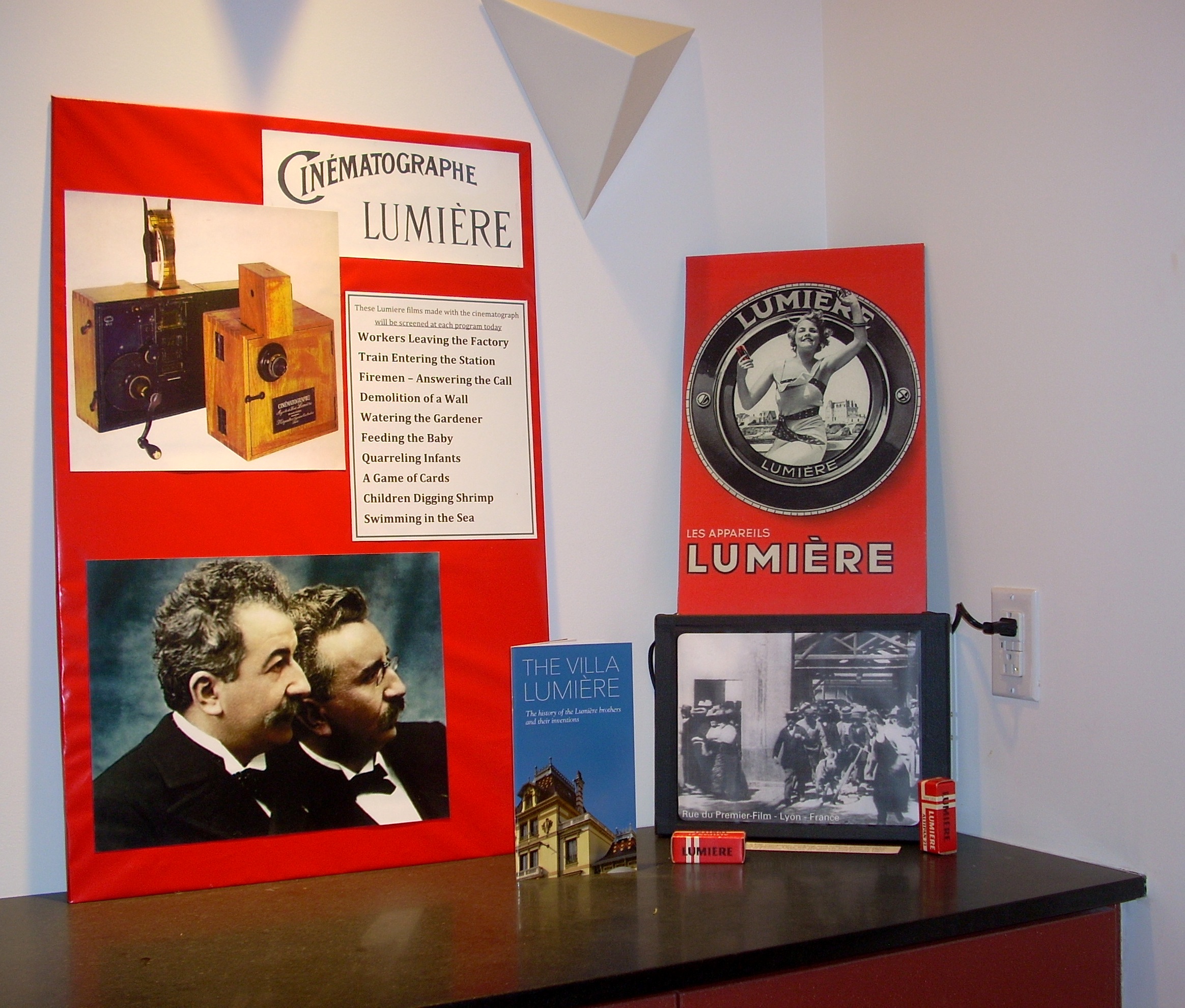 Here’s a great model for celebrating film history – 120 years of it, on this occasion.
Here’s a great model for celebrating film history – 120 years of it, on this occasion.
On 28 December 1895, the Lumière brothers, Auguste and Louis, presented a program in Paris of a novel form of entertainment: motion pictures. It took place at the Salon Indien du Grand Café on the Boulevard des Capucines. To commemorate that event, the Durham Cinematheque, in Durham, North Carolina, held a free, day-long film event on 28 December 2015 at the Durham Hotel, with some unusual features.
Organizer Tom Whiteside, a filmmaker, artist, and film historian who has been making, curating, and exhibiting film since 1977, screened films from that first Lumière program, as well as early “shorts” – news “actualité” films as well as trick films – by the Lumières and their contemporaries. Adding interest, along the way, were Whiteside’s reflections on the Lumières. “I like to drop tidbits into a screening,” he says. “People like the ‘extra-filmic’ information.” So, he observed that not only were Auguste and Louis Lumière married to sisters, “but did you know that their sisters were married to their wives’ brothers? That’s right, the Lumière family and the Winckler family had four marriages among them, same generation.”
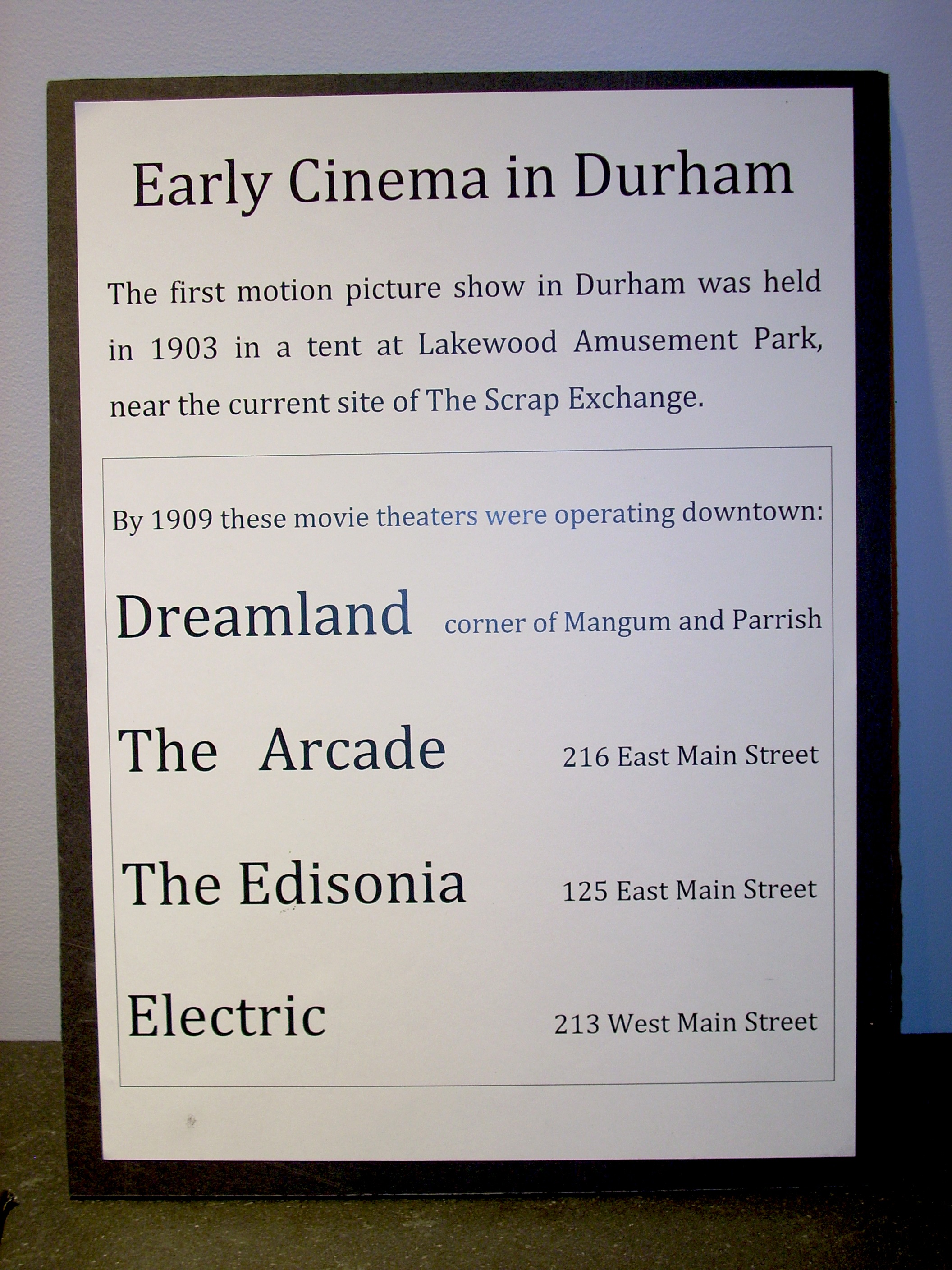 During the course of the day, Whiteside screened gems from his more than 30 years of collecting, particularly in the areas of early cinema and 20th-century experimental film. On show were 15 Lumière films, in all, as well as early films like Gay Shoe Clerk (1904), The Runaway Horse (1908), Revolution in Odessa (1905), Dream of a Rarebit Fiend (1906), Sandow (1896), and Boxing Cats (1894). As for experimental and more recent fare, Whiteside exhibited Rain, by Joris Ivens, from 1929; The Wonder Ring (1959) by Stan Brakhage; Whiteside’s own Riffs on Potemkin, which is a two-projector performance of the Odessa Steps sequence; Who Do You Think You Are (1987), by Mary Filippo; and a recent film by Roger Beebe, Historia Calamitatum (the story of my misfortunes) Part Two, The Crying Game. The last of those was made in 2014, “so it brought it up to date,” says Whiteside.
During the course of the day, Whiteside screened gems from his more than 30 years of collecting, particularly in the areas of early cinema and 20th-century experimental film. On show were 15 Lumière films, in all, as well as early films like Gay Shoe Clerk (1904), The Runaway Horse (1908), Revolution in Odessa (1905), Dream of a Rarebit Fiend (1906), Sandow (1896), and Boxing Cats (1894). As for experimental and more recent fare, Whiteside exhibited Rain, by Joris Ivens, from 1929; The Wonder Ring (1959) by Stan Brakhage; Whiteside’s own Riffs on Potemkin, which is a two-projector performance of the Odessa Steps sequence; Who Do You Think You Are (1987), by Mary Filippo; and a recent film by Roger Beebe, Historia Calamitatum (the story of my misfortunes) Part Two, The Crying Game. The last of those was made in 2014, “so it brought it up to date,” says Whiteside.
Also on the program was a display of film equipment, where film fans were able to get their hands on antique film cameras and projectors including a set of rewinds with 16mm film, a hand-cranked 16mm projector, and a “petting zoo” of working 16mm cameras including a 1929 Cine Kodak Model BB and a 1931 Bell & Howell Filmo. Projectors on display included a Kodascope Model B, a Pathé Baby, and a Bolex 321.
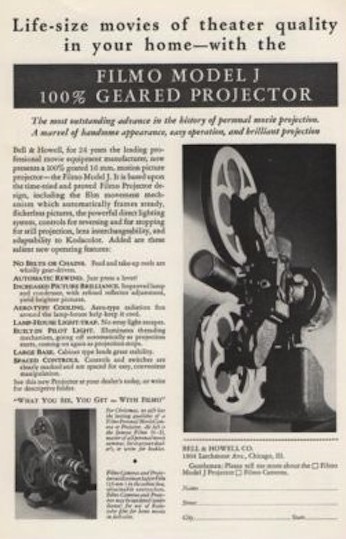 “As usual,” says Whiteside, “younger people were more interested in operating the hand cranked projector than were their parents. I even had two young assistants to show people how to use it — aged 11 and 9. I have a Bell and Howell model 153 that runs by motor or you can throw a clutch and crank it forward or backward by hand. I always point out that Demolition of a Wall really must have been the first thing anyone ever saw happen backwards in time, because they showed it backwards in 1895. This is important — from the beginning of human existence until the end of the 19th century no one had ever seen anything happen backward in time. Of course we are used to it now, but until Demolition of a Wall you’d practically have to be insane to even contemplate such a thing.”
“As usual,” says Whiteside, “younger people were more interested in operating the hand cranked projector than were their parents. I even had two young assistants to show people how to use it — aged 11 and 9. I have a Bell and Howell model 153 that runs by motor or you can throw a clutch and crank it forward or backward by hand. I always point out that Demolition of a Wall really must have been the first thing anyone ever saw happen backwards in time, because they showed it backwards in 1895. This is important — from the beginning of human existence until the end of the 19th century no one had ever seen anything happen backward in time. Of course we are used to it now, but until Demolition of a Wall you’d practically have to be insane to even contemplate such a thing.”
He also gave visitors an opportunity to watch a 1949 Jam Handy Chevrolet film Rough House on the hand-cranked projector.
One way Whiteside added extra visual interest to his collection of old cameras and projectors was to display a few of the many postage stamps that have been issued around the world with images of the Lumière brothers. Whiteside says he has only a small collection, “but I like the way it demonstrates how the Lumières were known and have been commemorated around the world — but not in the USA, so far as I can tell. I bought five stamps on eBay in the past few months — they’re inexpensive — from Central African Republic, France, Mali, Monaco, and St. Thomas. I saw a few more that had rather inaccurate illustrations, so I passed on those. The one from Mali is really a hoot, with little portraits of Jean Harlow and Marilyn Monroe in the lower corners.”
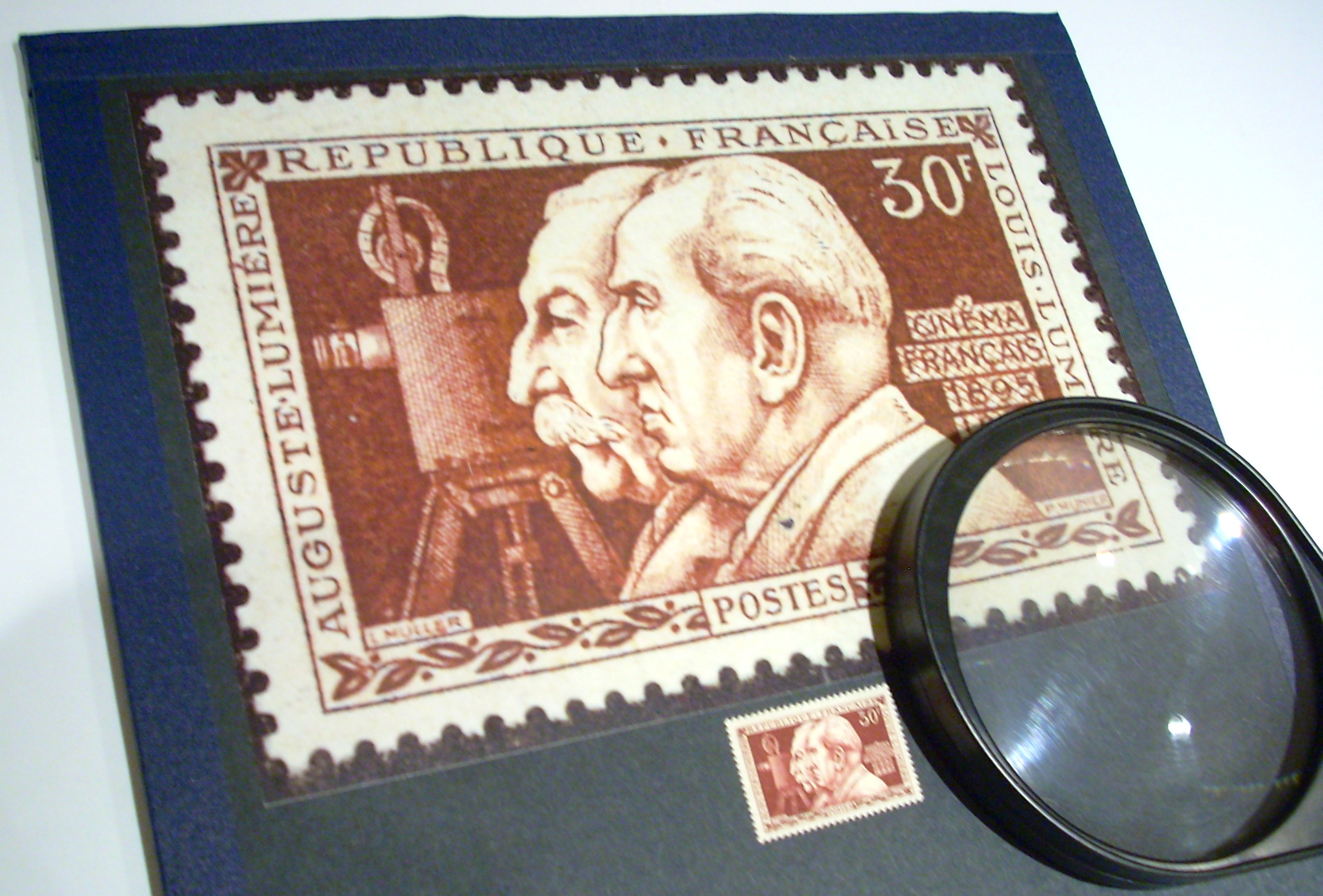 He made a display from a 1955 French stamp in which he placed an enlargement alongside the actual stamp, and provided a magnifying glass and a text box that read: “Cinema uses lenses to make small pictures bigger. Make your own movie.”
He made a display from a 1955 French stamp in which he placed an enlargement alongside the actual stamp, and provided a magnifying glass and a text box that read: “Cinema uses lenses to make small pictures bigger. Make your own movie.”
The events were very well attended, throughout the day. There were four screening sessions, and all were full in a room seating 55. It no doubt helped that the events were free of any admission charge, and that The Durham Hotel is itself an attraction, and its bar was open. To dress up the establishment even more, Whiteside displayed images on light boxes, including one from Workers Leaving the Factory on a light box.
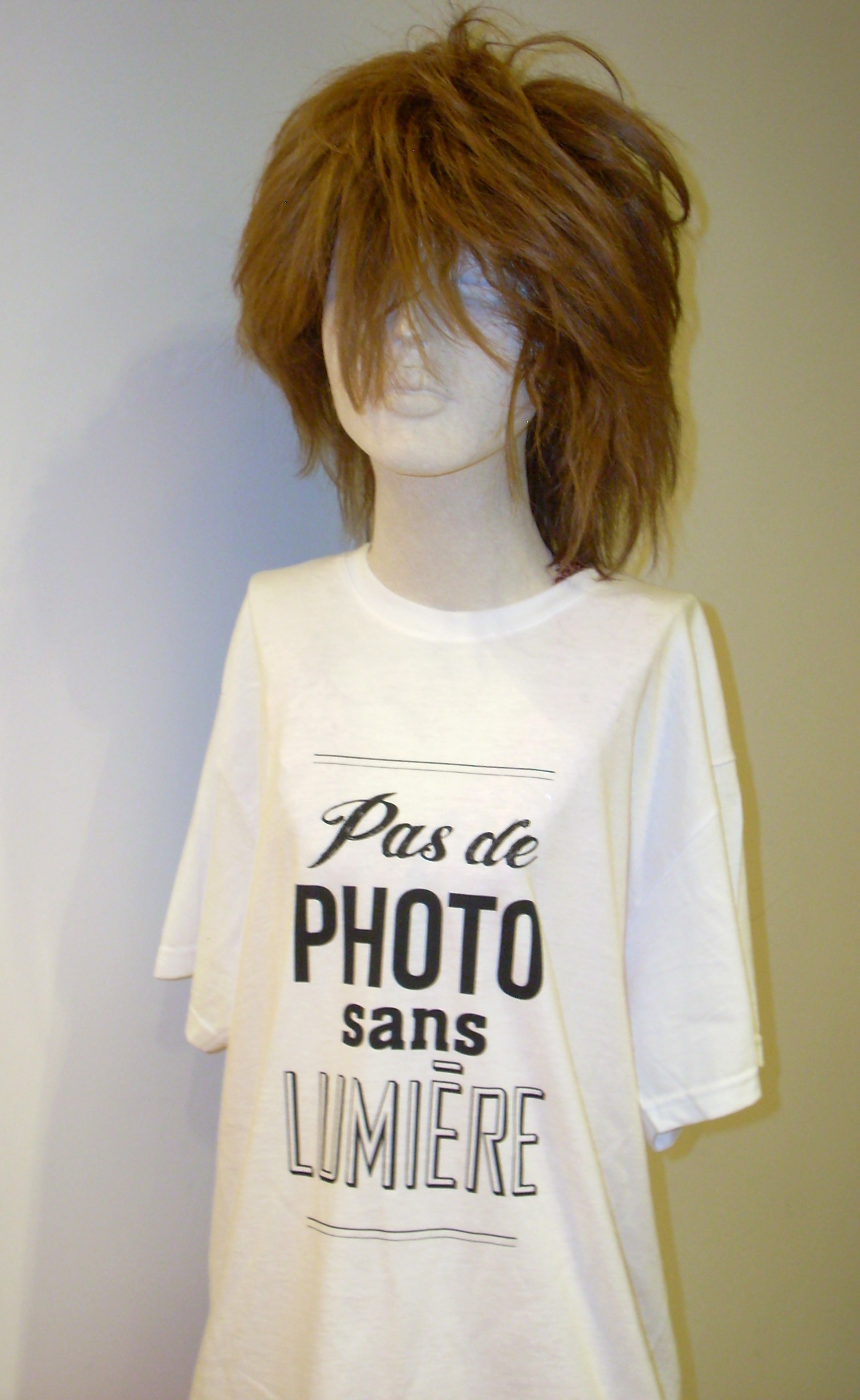 He sought to draw in Durham residents by displaying a listing of the cinemas of early-20th-century Durham, and through his selection of films for the event. He says: “When I moved to Durham in 1988 they were still making cigarettes downtown and the sweet smell of cured tobacco led me to collect 16mm films about smoking.” So, at the 28 December event, he showed a 1963 television commercial, Here’s Julie London singing the Marlboro song! “Tobacco built this city but left in the early 90’s,” he says. “Durham used to be known as ‘The City of Tobacco’ and is now called ‘The City of Medicine.’ Go figure. The Durham Cinematheque collection includes many cigarette commercials on 16mm, plus a March of Time film Tobacco Land USA that was shot here in 1939 and many other tobacco movies.”
He sought to draw in Durham residents by displaying a listing of the cinemas of early-20th-century Durham, and through his selection of films for the event. He says: “When I moved to Durham in 1988 they were still making cigarettes downtown and the sweet smell of cured tobacco led me to collect 16mm films about smoking.” So, at the 28 December event, he showed a 1963 television commercial, Here’s Julie London singing the Marlboro song! “Tobacco built this city but left in the early 90’s,” he says. “Durham used to be known as ‘The City of Tobacco’ and is now called ‘The City of Medicine.’ Go figure. The Durham Cinematheque collection includes many cigarette commercials on 16mm, plus a March of Time film Tobacco Land USA that was shot here in 1939 and many other tobacco movies.”
Durham Cinematheque is, by the way, just Whiteside — it’s a one-person organization, and he has been showing film under that moniker since 1991. But on the occasion of his Lumière celebration, he had a little help, he says: “My sister-in-law lives in Lyon so she did some shopping for Lumière swag at Institut Lumière — some posters, a brochure describing the museum, a nice lenticular postcard that shows the first bit of movement in Workers Leaving the Factory, the Lumières’ 1895 film.” Whiteside says he finds that people who come to events like his are always very curious about how film works, and to see the mechanics of it, up close.
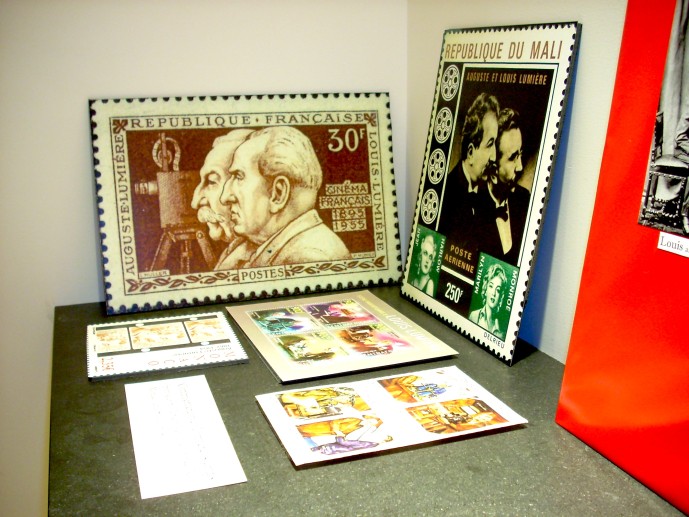
n
— Peter Monaghan
Printed from Moving Image Archive News: https://www.movingimagearchivenews.org
URL to article: https://www.movingimagearchivenews.org/how-to-celebrate-120-years-of-cinema/
Click here to print